Anti Aging

Global Anti-Aging Market Size By Type Of Product (Anti-Wrinkle, Hair Color, UV Absorbers, And Anti-Stretch Marks), Type Of Device (Radiofrequency, Laser, Anti-Cellulite And Microdermabrasion), By Treatment (Hair Restoration, Anti-Pigmentation, Anti-Adult Acne, Liposuction, Breast Augmentation And Chemical Peel), By Demography (Generation X, Baby Boomer And Generation Y); Growth And Demand Forecast, 2018-2025
- Published Date: August 2018
- Report ID: BWC1817
- Available Format: PDF
- Page: 210
Report Overview
Global Anti-Aging Market: Outlook
Global anti-aging market is projected to grow with a CAGR 7.9%, given the fact that there is a growth in the aging population, advancement of technology, growing awareness among the people from every part of the globe & increase in the disposable income as well. Moreover, the increasing volume of anti-aging process is expected to have a high impact on the global market. The growing aging population is more susceptible to getting wrinkles and scars, which increases the demand for anti-aging products and treatments.
Study period in terms of years:
Historical year: 2014-2016
Base Year: 2017
Forecast Year: 2018-2025
Global Anti-Aging Market: Growth Drivers
The global anti-aging market is driven by factors, such as an increase in volume of anti-aging procedures, growing aging population, the rise in anti-aging awareness campaigns, technological advancements, and an increase in disposable income. Increasing life expectancy and fall in birth rate are the major causes of aging population. The aging population develops wrinkles due to lack of nutrients in the body, exposure to UV light, smoking, dehydration, medications, and other genetic factors. Furthermore, since there is an increase in disposable income, people tend to search for anti-aging treatment options.
GLOBAL ANTI-AGING MARKET, BY TYPE OF PRODUCT, USD (MILLION), 2014 – 2025
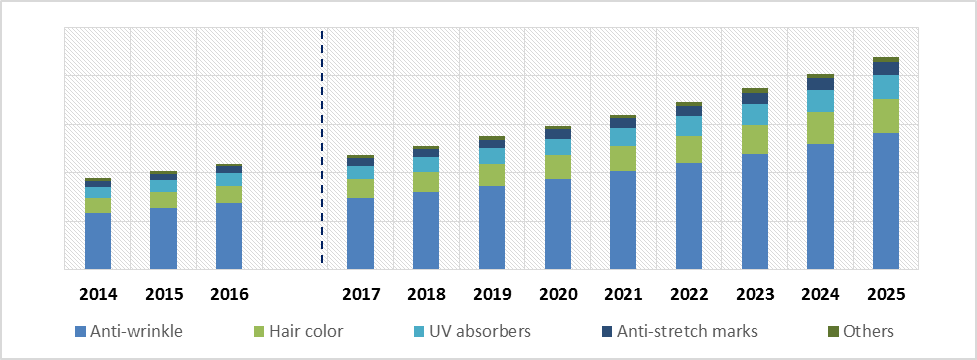
Global Anti-Aging Product Market: Key Stakeholders/Participants
·
Anti-aging product and device manufacturing
companies
·
Suppliers and distributors of anti-aging
products and devices
·
Hospitals, surgical centres, cosmetic clinics,
retailers and consumers
·
Market research and consulting firms
·
Government bodies and municipal corporations
Global Anti-Aging Product Market: Research Methodology
The research was conducted covering the desk research and primary research. Extensive secondary research was conducted using paid data sources, including Bloomberg, Factiva, OneSource, and Hoovers. Additionally, several publicly-available data sources were used, including American Geriatrics Society (AGS), Bureau of Labor Statistics (BEA), Centers for Disease Control and Prevention (CDC), Center for Devices and Radiological Health (CDRH), Organization for Economic Co-operation and Development (OECD), United Nations Department of Economic and Social Affairs (UN-DESA) and various journals. These data sources were used to gather industry related information to develop an understanding of anti-aging. Data sources used for primary research included, but were not limited to, distributors, manufacturers, physicians, surgeons, store managers and suppliers. Additionally, interviews were conducted through connecting with various industry respondents including C-level executives, directors, divisional heads, regional heads, expert consultants, and independent consultants. The primary research was conducted to gain market insights from industry respondents and validate the gathered information through desk research.
Global Anti-Aging Product Market: Research Summary
The growing popularity of anti-aging products and treatments is the combined result of consumer awareness coupled with an increase in disposable income. Moreover, the growing aging population due to higher life expectancy and increased awareness for birth control demands for a healthy and younger aging population. The increase in conferences and seminars is expected to have medium impact on the global market, since it is expected to create awareness about various anti-aging treatments.
·
Anti-wrinkle products segment is expected to be
the largest contributor in the global anti-aging market; contributing over
62.7% share in 2017 and is further expected to reach over 64.3% by 2025. The
growth of anti-wrinkle products can be attributed to growing concern towards
appearances and awareness among women about anti-wrinkle products
·
Based on type of devices, radiofrequency is
expected to lead the anti-aging market, with a CAGR over 51.7% by 2025. Factors
such as an increase in the aging population and increasing prevalence of skin
photoagingare the major driving force of the market
·
Based on demography, generation X is expected to
lead the anti-aging market in accounting over 59.8% share in 2017, which is
expected to record market share at 61.4% by 2025. Factors such as increasing
awareness about anti-aging treatments in treating aging spots and wrinkles are
driving the market growth
·
The report also gives a detailed description of
which segment of anti-aging market are doing well in terms of market analysis
of different regions around the globe- North America, Europe, Asia-Pacific,
Latin America and Rest of the World
Global Anti-Aging Product Market: Competitive Dynamics
The research states that the global anti-aging market is highly competitive, with players developing new technologies and providing the customers with a plate full of options to choose from. Some of the key players in the global anti-aging product market are L’Oreal, Procter & Gamble (in terms of offering a number of products), and other brands offering anti-aging products are Helena Rubinstein, Vichy, and SkinCeuticals. The key players manufacturing the anti-aging devices include Nu Skin Enterprises, Lumenis Ltd, Cynosure, Inc., and Solta Medical Inc. (Valeant Pharmaceuticals).
-Chapter 1. Research Scope and Methodology
1.1 Research Objectives
1.2 Market Definition
1.2.1 Market segmentation by type of product
1.2.2 Market segmentation by type of device
1.2.3 Market segmentation by treatment
1.2.4 Market segmentation by demography
1.2.5 Market segmentation by geography
1.2.6 Analysis period
1.2.7 Market data reporting unit
1.3 Key Stakeholders
Chapter 2. Research Methodology
2.1 Secondary Research
2.2 Primary Research
2.2.1 Breakdown of primary research respondents
2.2.1.1 By region
2.2.1.2 By industry participants
2.2.1.3 By company type
2.3 Market Size Estimation
2.4 Market Breakdown and Data Triangulation
2.5 Assumptions for the Study
Chapter 3. Introduction
3.1 Market segmentation
3.1.1 Overview by type of product
3.1.1.1 Anti-wrinkle products
3.1.1.2 Hair color
3.1.1.3 UV absorbers
3.1.2 Overview by type of device
3.1.2.1 Radiofrequenc(RF)devices
3.1.2.2 Laser devices
3.1.2.3 Anti-cellulite devices
3.1.2.4 Microdermabrasion devices
3.1.3 Overview by treatment
3.1.3.1 Hair restoration
3.1.3.2 Anti-pigmentation
3.1.3.3 Anti-adult acne
3.1.3.4 Liposuction
3.1.3.5 Breast augmentation
3.1.3.6 Chemical peels
3.1.4 Overview by demography
3.1.4.1 Baby boomer
3.1.4.2 Generation X
3.1.4.3 Generation Y
3.2 Market Dynamics
3.2.1 Trends
3.2.1.1 Strategic Decisions taken by the key players
3.2.2 Drivers
3.2.2.1 Growth in the aging population
3.2.2.2 Increase in anti-aging awareness campaigns
3.2.2.3 Technological advancements
3.2.2.4 Increase in disposable income
3.2.2.5 Conclusion
3.3 Restraints
3.3.1 Expensive products/devices
3.3.2 Regulatory frameworks
3.3.3 Anti-aging devices considered as unsafe
3.3.4 Conclusion
3.4 Opportunities for the market
3.4.1 Convenient non-surgical treatments
3.4.2 Growing trend of social network and e-commerce
3.5 Porter’s Five Forces of Competitive Position Analysis
3.5.1 Bargaining power of buyers
3.5.2 Bargaining power of suppliers
3.5.3 Threat of new entrants
3.5.4 Intensity of rivalry
3.5.5 Threat of substitutes
Chapter 4. Global Anti-Aging Market, by Type of Product
4.1 Global Anti-Wrinkle Products Market
4.1.1 Global anti-wrinkle products market, by type
4.1.2 Global anti-wrinkle products market, by region
4.2 Global Hair Color Market
4.2.1 Global Hair Colour Market, By Region
4.3 Global UV Absorbers Market
4.3.1 Global UV absorbers market, by region
4.4 Global Anti-Stretch Marks Market
4.4.1 Global anti-stretch marks market, by region
4.5 Global Anti-Aging Market for Other Products
4.5.1 Global anti-aging market for other products, by region
Chapter 5. Global Anti-Aging Market, by Type of Device
5.1 Global Anti-Aging Market for Radio Frequency (RF) Devices
5.1.1 Global anti-aging market for RF Devices, by region
5.2 Global Anti-Aging Market for Laser Devices
5.2.1 Global anti-aging market for laser devices, by region
5.3 Global Anti-Aging Market for Anti-Cellulite Devices
5.3.1 Global anti-aging market for anti-cellulite devices, by region
5.4 Global Anti-Aging Market for Microdermabrasion Devices
5.4.1 Global anti-aging market for microdermabrasion devices, by region
Chapter 6. Global Anti-Aging Market, by Treatment
6.1 Global Anti-Aging Market for Hair Restoration
6.1.1 Global anti-aging market for hair restoration, by region
6.2 Global Anti-Aging Market for Anti-Pigmentation
6.2.1 Global anti-aging market for anti-pigmentation, by region
6.3 Global Anti-Aging Market for Anti-Adult Acne
6.3.1 Global anti-aging market for anti-adult acne, by region
6.4 Global Anti-Aging Market for Liposuction
6.4.1 Global anti-aging market for liposuction, by region
6.5 Global Anti-Aging Market for Breast Augmentation
6.5.1 Global anti-aging market for breast augmentation, by region
6.6 Global Anti-Aging Market for Chemical Peel
6.6.1 Global anti-aging market for chemical peel, by region
6.7 Global Anti-Aging Market for Other Treatments
6.7.1 Global anti-aging market for other treatment, by region
Chapter 7. Global Anti-Aging Market, by Demography
7.1 Global Anti-Aging Market, by Demography
7.2 Global Anti-Aging Market for Generation X
7.2.1 Global anti-aging market for generation X, by region
7.3 Global Anti-Aging Market for Baby Boomer
7.3.1 Global anti-aging market for baby boomer, by region
7.4 Global Anti-Aging Market for Generation Y
7.4.1 Global anti-aging market for generation Y, by region
Chapter 8. Global Anti-Aging Market, by Geography
8.1 North America Anti-Aging Market
8.1.1 North America anti-aging market, by type of product
8.1.2 North America anti-aging market, by type of device
8.1.3 North America anti-aging market, by treatment
8.1.4 North America anti-aging market, by demography
8.1.5 North America anti-aging market, by country
8.2 Europe Anti-Aging Market
8.2.1 Europe anti-aging market, by type of product
8.2.2 Europe anti-aging market, by type of device
8.2.3 Europe anti-aging market, by treatment
8.2.4 Europe anti-aging market, by demography
8.2.5 Europe anti-aging market, by country
8.3 Asia-Pacific(APAC)Anti-AgingMarket
8.3.1 APAC anti-aging market, by type of product
8.3.2 APAC anti-aging market, by type of device
8.3.3 APAC anti-aging market, by treatment
8.3.4 APAC anti-aging market, by demography
8.3.5 APAC anti-aging market, by country
8.4 Latin America(LATAM) Anti-Aging Market
8.4.1 LATAM anti-aging market, by type of product
8.4.2 LATAM anti-aging market, by type of device
8.4.3 LATAM anti-aging market, by treatment
8.4.4 LATAM anti-aging market, by demography
8.4.5 LATAM anti-aging market, by country
8.5 Rest of the World (RoW)Anti-Aging Market
8.5.1 RoW anti-aging market, by type of product
8.5.2 RoW anti-aging market, by type of device
8.5.3 RoW anti-aging market, by treatment
8.5.4 RoW anti-aging market, by demography
Chapter 9. Competitive Analysis
9.1 Comparison of Key Players Based on Product Offerings
9.2 Market Share Analysis of Key Players
9.2.1 Global anti-aging products market share analysis of key players
9.2.2 Global anti-aging devices market share analysis of key players
9.3 Global Strategic Developments
9.3.1 Merger & acquisition
9.3.2 Collaborations and partnerships
9.3.3 Product launch
Chapter 10. Company Profiles
10.1 L’Oreal
10.1.1 Business overview
10.1.2 Product and service offerings
10.1.3 SWOT analysis
10.2 The Proctor & Gamble Company
10.2.1 Business overview
10.2.2 Product and services offerings
10.2.3 SWOT analysis
10.3 Beiersdorf AG
10.3.1 Business overview
10.3.2 Product and service offerings
10.3.3 SWOT analysis
10.4 Allergan Plc.
10.4.1 Business overview
10.4.2 Product and service offerings
10.4.3 SWOT analysis
10.5 The Estee Lauder Companies Inc.
10.5.1 Business overview
10.5.2 Product and service offerings
10.5.3 SWOT analysis
10.6 Nu Skin Enterprises, Inc.
10.6.1 Business overview
10.6.2 Product and service offerings
10.6.3 SWOT analysis
10.7 Johnson & Johnson
10.7.1 Business overview
10.7.2 Product and service offerings
10.7.3 SWOT analysis
10.8 Coty Inc.
10.8.1 Business overview
10.8.2 Product and service offerings
10.8.3 SWOT analysis
10.9 Cynosure, Inc.
10.9.1 Business overview
10.9.2 Product and service offerings
10.10 Lumenis Ltd.
10.10.1 Business overview
10.10.2 Product and service offerings
10.11 Syneron Medical Ltd.
10.11.1 Business overview
10.11.2 Product and service offerings
10.12 Solta Medical Inc.
10.12.1 Business overview
10.12.2 Product and service offerings
10.12.3 SWOT analysis
10.13 Photomedex Inc.
10.13.1 Business overview
10.13.2 Product and service offerings
10.14 Orlane
10.14.1 Business overview
10.14.2 Product and service offerings
10.15 Personal Microderm
10.15.1 Business overview
10.15.2 Product and service offerings
10.16 Alma Lasers Ltd.
10.16.1 Business overview
10.16.2 Product and service offerings
Chapter 11. Appendix
11.1 List of Abbreviations
11.1.1 Product launch and approval
Market Segmentation
1. Research Methodology
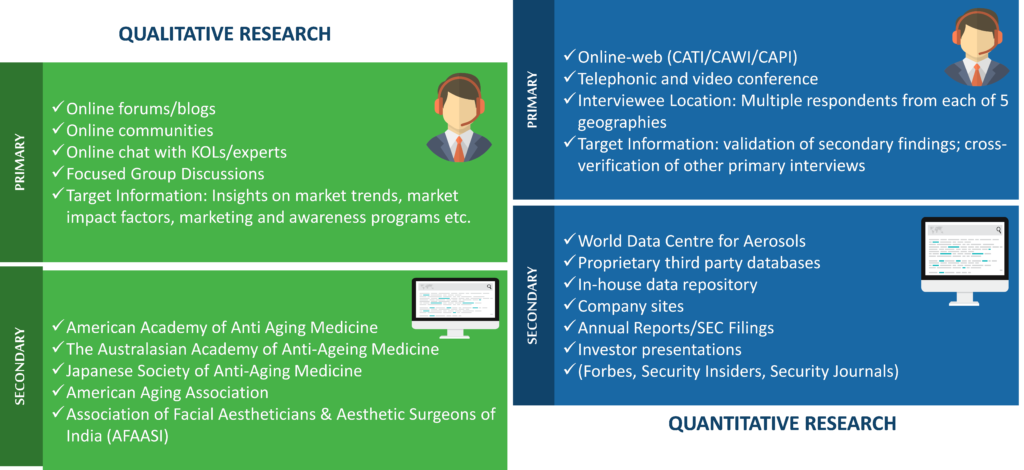
2. Regional Split of Primary & Secondary Research
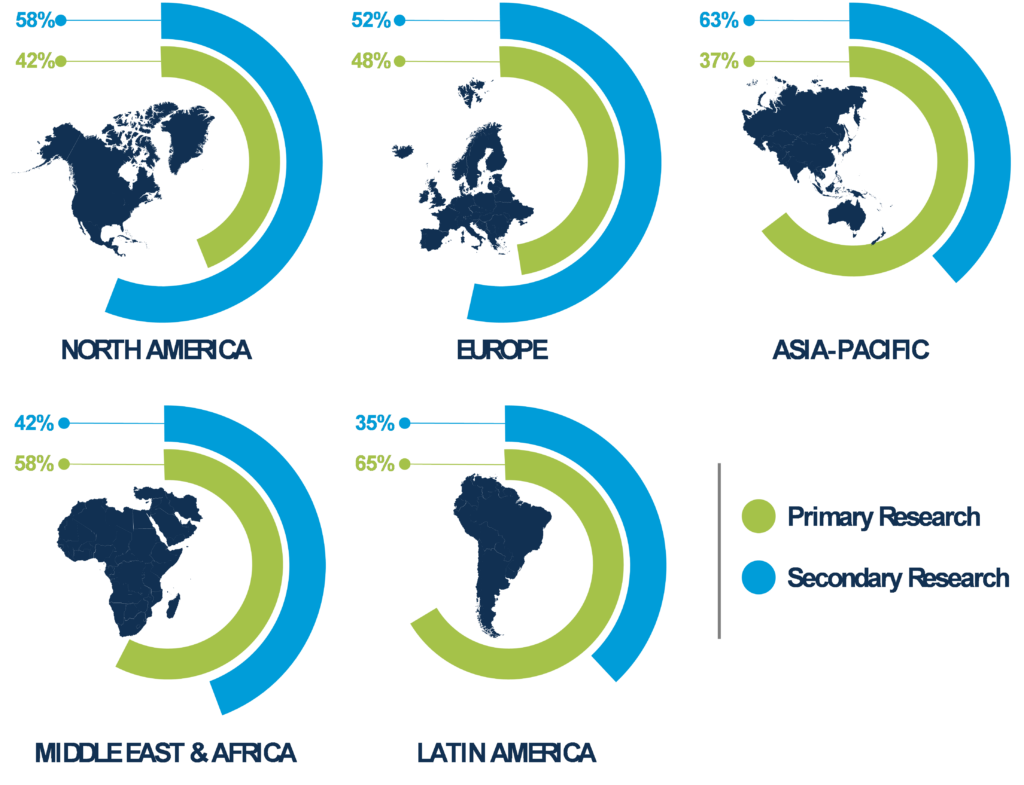
3. Secondary Research
The research process began with obtaining historical market sizes of the entire anti-aging market and the share of each type of segmentation, through exhaustive secondary research to understand the potential of the market under the prevailing market environment during the past years. The growth rate of the market and its segments was studied with a comparative approach to understand the impact of factors that shaped the market during the recent past.
The next step involved the study of present market environment that is influencing the anti-aging market and its expected long-term impact. Weightage was given to several forces that are expected to affect the home security market, during the forecast period. Based on the interim analysis, the market numbers were formulated for each of the forecast years for every segment.
4. Primary Research
Various industry experts including CEOs, presidents, vice presidents, directors, sales managers, products managers, organization executives and other key people of the global anti-aging market were interviewed. The third step involved validation of hypothesis through segmented primary research with the key opinion leaders in the industry, including the company representatives, experts from distributer agencies, service providers and other industry experts. The primary research helped in assessing the gathered and assumed data with the real-time experience of industry representatives. This also led to modification in certain assumptions that were taken during the process of preliminary research. The analysts arrived at solid data points after the completion of primary research process.
In the fourth step, the market engineering was conducted, where the data points collected through secondary and primary sources were compiled to compute the final market sizes.
4.1 Breakdown of Primary Research Respondents, By Region
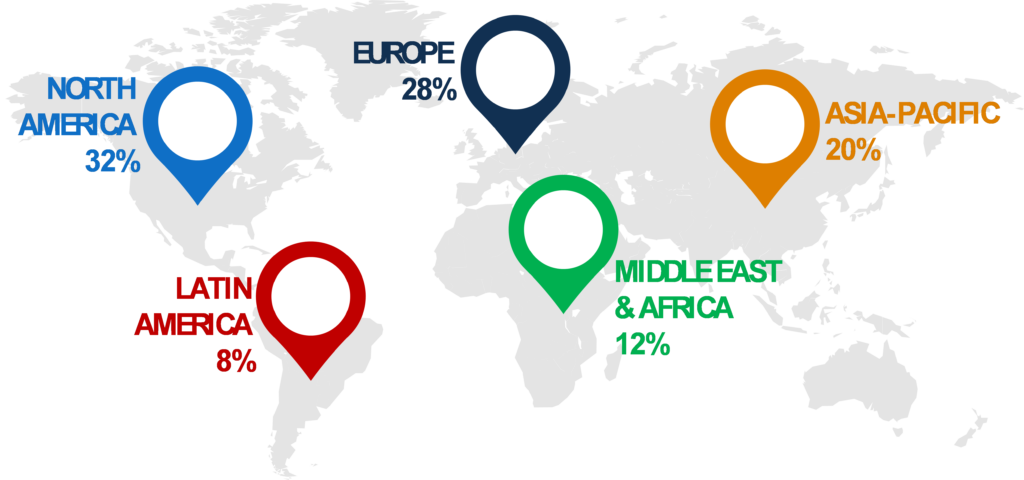
4.2 Breakdown of Primary Research Respondents, By Industry Participants

5. Market Size Estimation
Top-down approach has been followed to obtain the market size by region, and by country. Bottom-Up approach has been followed to obtain market size by type product, by type of device, by treatment and by demography.
An amalgamation of bottom-up and top-down approach has been performed to determine the revenue.
6. Assumptions for the Study
- The macro-economic factors would remain same during the forecast period.
- The market players would exhibit consistent performance during the forecast period without having any adverse ripple effects on the industry.
7. Market Breakdown & Data Triangulation
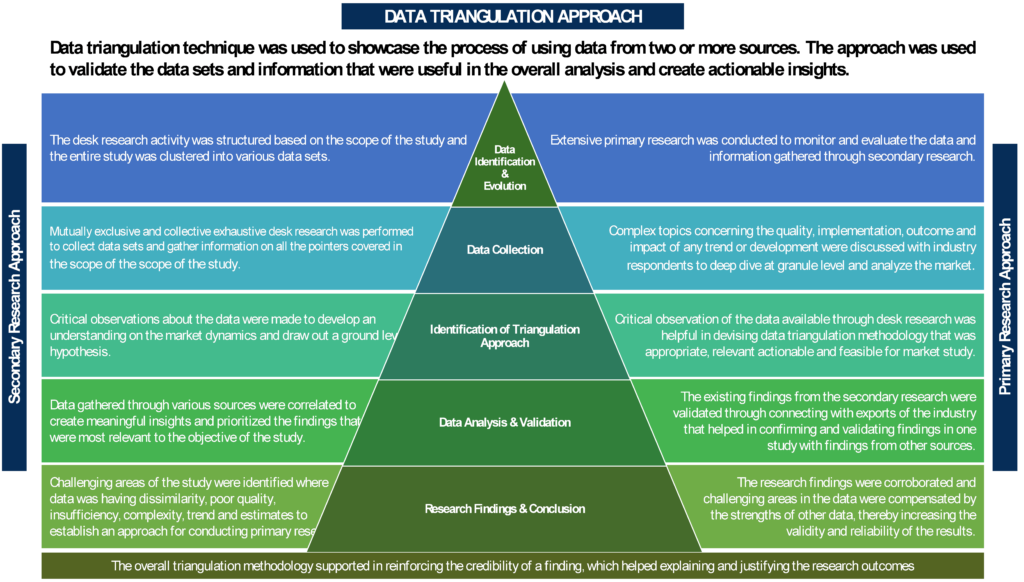
To request a free sample copy of this report, please complete the form below.
We value your investment and offer free customization with every report to fulfil your exact research needs.
RELATED REPORTS
WHY CHOOSE US
-

24/7 Research support
Get your queries resolved from an industry expert. Request for a free product review before report purchase.
-

Coustom Research Service
Ask the Analyst to customize an exclusive study to serve your research needs
-

Quality & Accuracy
Ask the Analyst to customize an exclusive study to serve your research needs
-

Data Visualization
As the business world is changing dynamically every day. We need to stay pin point in relation to data management and optimum data utilization
-

Information security
We never share your personal and confidential information. Your personal information is safe and secure with us.


